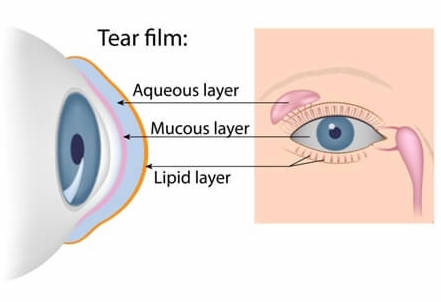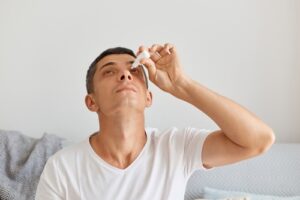Do you have dry, itchy, or watery eyes? Are you plagued by dryness that never seems to improve?
Many people struggle with dry eyes. There are numerous reasons your eyes may feel irritated and dried out.
If you have dry eyes for a brief period and the symptoms go away on their own, you usually don’t need to worry about any long-term effects on your eyes. But if your eyes feel dry frequently or constantly, you may have dry eye syndrome.
Left untreated, dry eye syndrome can damage your eyes and even lead to vision loss. This is why it’s essential to know if you’re suffering from dry eye syndrome so you can get treatment.
But how do you know if you have dry eye syndrome? Keep reading to discover if your dry eyes could be temporary or something more!
What Makes Your Eyes Feel Dry?

If you have dry eyes, you may experience several symptoms. Your eyes may feel like they burn, sting, itch, are gritty, or are inflamed.
These symptoms indicate that your eyes aren’t getting enough moisture. Your eyes regularly produce tears that disperse over the surface of your eyes to keep them moisturized, which is how they stay healthy.
When there’s an issue with tear production or dispersion, your eyes don’t get enough moisture, making them dry and irritated. Several things can cause problems with tear production and distribution.
These issues may be temporary and caused by your environment. For example, in dry weather, your tears will evaporate faster, so they may not be able to disperse completely to moisturize your eyes adequately.
Being dehydrated and wearing contact lenses improperly are also temporary factors that may contribute to dry eye symptoms. But when you have temporary dry eye symptoms, the symptoms will subside once the cause (like your environment) is addressed.
If your eyes continue to feel drier than they should for a long time, even after changes to your environment, it may be due to dry eye syndrome.
What is Dry Eye Syndrome?

Dry eye syndrome is a chronic condition triggered by an underlying medical issue affecting your tear production. Tear production is affected by how many tears you can produce and the quality of your tears.
Often, the underlying cause is hard to pinpoint. Skin conditions and chemical changes in the body often trigger it.
Dry eye syndrome is more common in older patients and women, especially those going through hormonal changes. One common factor in many patients with dry eye syndrome is meibomian gland dysfunction.
Your tears are coated in lipids, an oil produced by the meibomian glands. This oil film keeps your tears from evaporating too quickly.
But if your meibomian glands have trouble secreting oil, your tears lack this coating. Without the oil coating, your eyes don’t get enough moisture because your tears don’t have enough time to disperse.
Luckily, whether your dry eyes are temporary or due to dry eye syndrome, there are ways to relieve your symptoms.
What To Do To Relieve Your Dry Eye Symptoms

If your dry eye symptoms are temporary, correcting your environmental factors should help. This may mean drinking more water, taking a break from wearing contact lenses, reducing time spent looking at screens, or using a humidifier in your home or office.
If these small changes don’t alleviate your symptoms, it’s time to seek professional treatment at Loden Vision Centers.
Professional Dry Eye Syndrome Treatment
If you have persistently dry eyes, make an appointment to see your ophthalmologist. They’ll be able to diagnose you by taking a sample of your tears and assessing their quality.
After receiving a diagnosis, they can recommend various simple lifestyle changes and medications. What they recommend will depend on the severity of your symptoms and the root cause of your dry eyes.

Most eye doctors recommend artificial tears and eye drops to relieve irritation and dryness. You can buy them over-the-counter at most drug stores, although your eye doctor can tell you what kind is best for you to use.
They may also recommend nutritional supplements. Omega-3 fatty acids are essential for healthy tear production. You can get more omega-3 by taking fish oil or flaxseed oil pills, but you can also get them by consuming more fatty fish, walnuts, and seeds.
Dry eye syndrome is sometimes caused by skin conditions that cause eyelid inflammation. If this is the case, your ophthalmologist may recommend cleaning your eyelids regularly with eyelid wipes or an eyelid scrub.
When simple lid hygiene isn’t effective, they may prescribe eye drops that treat inflammation and aid in tear production. If none of the treatments for dry eye syndrome described above alleviate all your dry eye symptoms, there are in-office treatments that often work to treat even the most severe dry eye syndrome.
LipiFlow
At Loden Vision Centers, we offer LipiFlow, a non-invasive, non-surgical therapy that uses gentle heat to soften blocked oils in the meibomian glands. We’re the only practice in the state that offers this highly effective treatment for meibomian gland dysfunction.
We also offer a procedure called punctal occlusion, another non-invasive treatment involving inserting tiny plugs into the puncta. The puncta are the tear ducts located near the corner of your eye.
By blocking off these ducts, your tears are forced to stay on the surface of your eye longer, allowing for better dispersal.

Your dry eyes may indicate a chronic condition, but you don’t have to suffer from dry eye syndrome’s uncomfortable and harmful symptoms. If you’re ready to do something about your dry eyes, make an appointment today with one of our specialists.
Schedule yours today at Loden Vision Centers in Nashville, TN, and get the relief you need!


